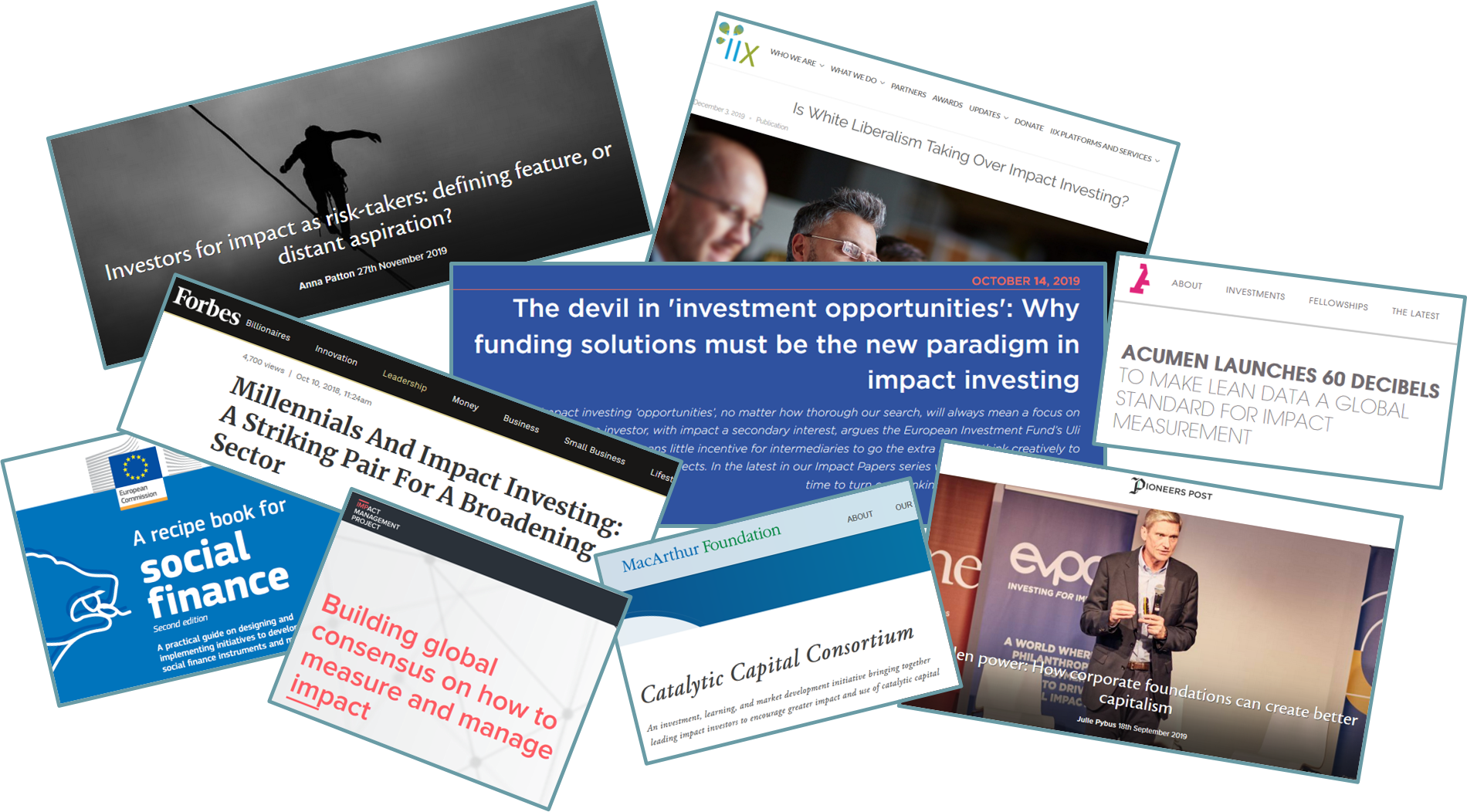Inspired by EVPA’s reflections on „15 Years of Impact – Taking Stock and Looking Ahead“, FASE’s recent 6th anniversary was the perfect occasion for us to look at our part in the European social finance endeavor. Do we fully share EVPA’s findings or come to slightly different conclusions? Here are our experiences from building bridges between enthusiastic impact investors and passionate social entrepreneurs in an everything-but-perfect ecosystem.
Long before impact investing became mainstream, we shared one specific characteristic with EVPA: “Investors FOR impact” were the vast majority in our network.
This is no surprise. Back in 2013, when FASE made its first steps in supporting social entrepreneurs to secure the financing they more than deserve, the number of impact investors was small. Most of them were deep impact enthusiasts and social business angel pioneers. To expand our network, we had to tirelessly knock on doors and explain what it really means to invest in early-stage social ventures. Often, we faced a wave of prejudices and binary mind-sets: For some capital providers, – whether they came from the philanthropic or the commercial worlds -, it was simply too hard to imagine that you can actually do BOTH, invest for positive returns AND support social innovation. So we had to spend a lot of time debunking myths about the real versus perceived risk of impact investing and about the true long-term impact of classic philanthropy. Our favorite claim back then: “One Euro of donation creates impact only once, one Euro of investment can do so multiple times”. The argument didn’t always fly. We had to create new and often hybrid financing models so that social entrepreneurs could outmaneuver the dizzying gaps in the ecosystem. At that time, the social finance market hadn’t come up with enough fitting solutions yet.
Honestly, it wasn’t an easy ride.
The entire FASE team consisted of two founders. Good publications and education on social finance were rare. Investing for impact was a tiny spot in a vast financing galaxy that was just about to discover sustainable strategies. And our clients, the social entrepreneurs, were often skeptic how it would feel to have impact investors aboard.

On the red sofa: Ellinor Schweyer and Markus Freiburg shortly after founding FASE in 2013.
2020: A different universe
Fast forward 6 years and we’re in the middle of a different universe. Today, it is rather hard to follow the daily flood of insightful impact publications. There are entire guides and recipe books for social finance, critical takes on the roles of investors such as “Investors for impact as risk-takers: defining feature, or distant aspiration?”, expert opinions on additionality such as “The devil in ‘investment opportunities’: Why funding solutions must be the new paradigm in impact investing”, candid blogs about the state of play of inclusion such as “Is White Liberalism Taking Over Impact Investing?” or heated debates about how to really achieve the SDGs and finally start asking those stakeholders for whom we originally set out to achieve impact: the beneficiaries.
So what has changed in these past 6 years?
The social finance ecosystem has evolved. Climate change, inclusion and poverty have become more pressing issues than ever (or just more visible for everyone). Impact investing is now a hype, with the typical positive and negative side effects. Social entrepreneurs are more aware of (and versed in) their options to finance scale. There are many incubators, accelerators, educators and support organisations for social changemakers out there. Public and philanthropic funders are busy investigating more effective catalytic approaches. Impact management tools have become lean and impact data points more abundant. A new wave of impact enthusiasts has emerged with the next generation of wealth owners. And FASE has passed the test of time with more than 50 transactions and EUR 25 million closed.

Only a fraction of major impact news in 2019
6 years of FASE: lessons learned
So what have we learned from this adventurous journey? First of all, it takes a challenging mix of vision, acceptance, flexibility and persistence to follow through with your mission. In this respect, we are in the same boat as our clients, the social entrepreneurs. Without our network of tireless supporters, from BMW Foundation to Ashoka to the European Commission, it would have been much harder – and maybe impossible – to make it this far. Yet we also learned a lot about the impact finance universe as such. So here come our main insights about what has changed in the ecosystem to the better and where reality still lags behind the vision:
(1) Impact investments have become mainstream – but still not accessible for every social entrepreneur.
It is true: industry experts and media report a sharp increase in number of impact investors and size of funds and allocations to impact. The Global Impact Investor Network (GIIN) sized the global market for impact investing at US$ 502 billion last year. BlackRock’s CEO Larry Fink just announced that the firm, – managing an incredible US$ 7 trillion in assets -, will put environmental sustainability as a core goal in investment decisions. And asset managers today cannot afford to have NO products for their clients with at least some sort of impact claim on the label. This is very good news.
However, the question is: Does this automatically improve the flow of capital to early-stage social ventures? Not necessarily. The biggest slice of the impact finance cake continues to target returns of (close to) market-rate (see graph below). For many social enterprises in early stages, this is simply too high to be met. So we decided to challenge the status quo and launch an innovative fund vehicle for German investors, which will engage in a diversified portfolio of investment-ready, early-stage social enterprises. The novelty of this “EUROPEAN SOCIAL INNOVATION AND IMPACT FUND” (“ESIIF”): It is the first ever mezzanine fund in the German impact market to receive a guarantee mechanism (“EaSI“) provided by the European Investment Fund. After more than 3 years of hard work, we hope that the “ESIIF” will become a real game-changer for social enterprises, German investors and the impact ecosystem as such.

85% of impact investors target (closer to) market-rate returns
(GIIN, Annual Impact Investor Survey 2019)
(2) Impact management tools are simpler and more shared – but still not sufficiently used.
In the meantime, there have been many initiatives striving to develop shared and simpler impact management principles and tools, for example the Impact Management Project or Acumen’s Lean Data. On top, all impact actors, whether entrepreneurs, intermediaries or investors, now look at the Sustainable Development Goals (SDGs) as THE guiding framework. This is wonderful news.
Yet does this lead to impact measurement being more seriously and frequently used? In our experience: not necessarily. While some investors are pushing the boundaries to move to measuring outcomes, others are happy with tracking a few more or less insightful indicators. In our view, the positive impact that social enterprises create has to become visible and monetized, if we want to enable a thriving ecosystem for social finance. If investors opt to “bake” impact into the financial instruments they use, we will be one big step ahead. When talking to our clients, we often advise to include impact incentives into their (hybrid) financing models. Once these milestones are achieved, the enterprises can enjoy reduced cost of capital. This gives them more leeway to pursue what is at the heart of their ventures: scaling impact in a sustainable way.
(3) Impact investing is a continuum – not a set of well-defined boxes.
No doubt, it is very important to understand the distinction between “investors FOR impact” and “investors WITH impact”. In practice, however, the lines are often blurred. Which type of impact-return-risk profile an investor may seek is sometimes not clear from the start. In addition, the profile might change over time as the investor gets more and more experienced. As outlined above, there are also limits as to which return expectations social enterprises can meet, specifically those working with untested business models in pioneer markets.
In our network of more than 1,000 individuals, impact funds, foundations, business angels, ethical banks, venture capital firms, asset managers, family offices and corporates, there are many who started to invest in impact in a rather opportunistic way. Some were more inspired by the entrepreneurs’ personalities, impact journeys and themes. Others approached the topic in a very strategic and systemic way. The good news: There are enough targets out there for any type of investor. While FASE mainly began to work with investors FOR impact in 2013, today we can serve all types of investors across the returns continuum.

BOTTOM LINE:
The ecosystem has evolved – and so has FASE. As we overcome hurdles and continue to grow, we are hugely grateful to those clients, investors, funders, advisors and friends who supported us on our journey since day one. Let’s build even more bridges for impact together in these roaring 2020ies!
Ellinor and Markus



